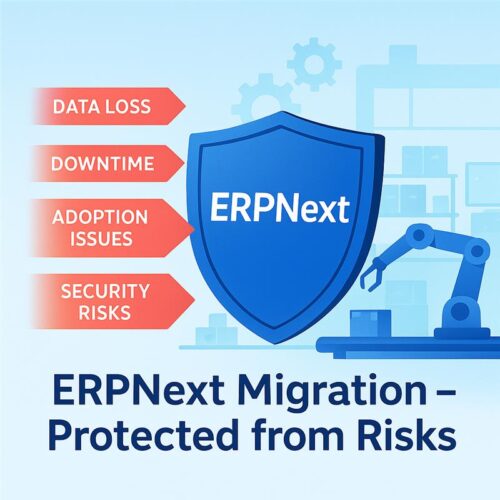ERPNext Data Migration, Customization & Adoption – Common Pitfalls and Solutions
Migrating to ERPNext, one of the most robust and flexible open-source ERP systems, is often a significant step for enterprises aiming to streamline operations, enhance visibility, and improve efficiency. ERPNext offers an integrated platform covering finance, supply chain, manufacturing, sales, HR, and more, making it an attractive choice for companies across industries.
However, ERP migrations are rarely straightforward. Businesses often encounter unexpected roadblocks that delay timelines, increase costs, or disrupt operations. Understanding these ERPNext migration challenges in advance—and preparing with the right strategies—can make the difference between a smooth transition and a stressful one.
In this article, we’ll explore the most common ERPNext migration challenges organizations face and provide practical solutions to overcome them.
1. Data Migration Issues
The Challenge:
One of the biggest pain points in ERPNext migration is transferring existing business data. Companies often deal with years of information spread across legacy systems, spreadsheets, and even manual records. Challenges include:
- Data inconsistencies (e.g., duplicate customer records).
- Format mismatches between the old system and ERPNext.
- Corrupted or incomplete records leading to reporting errors.
The Solution:
- Conduct a comprehensive data audit before migration to identify errors, duplicates, and outdated records.
- Use data cleaning tools to standardize formats and remove redundancies.
- Leverage ERPNext’s data import/export features or develop custom scripts for smoother mapping.
- Run a pilot migration with sample data to detect gaps before full migration.
- Involve stakeholders from finance, HR, and operations to validate migrated datasets.
Pro Tip: Don’t migrate unnecessary legacy data—archive it instead. This reduces risk and keeps ERPNext clean from day one.
2. Customization & Compatibility Concerns
The Challenge:
Every business operates differently. Some companies heavily customize workflows in legacy ERPs or depend on third-party tools for analytics, e-commerce, or CRM. When moving to ERPNext, businesses may worry about whether these unique requirements can be replicated or integrated.
The Solution:
- Prioritize business-critical workflows that must be customized in ERPNext.
- Take advantage of the Frappe framework, which allows modular customization without breaking core functionality.
- Test integrations in a sandbox environment before go-live to identify API or compatibility issues.
- Where possible, replace multiple third-party tools with ERPNext’s native modules to simplify the tech stack.
Pro Tip: Document every customization request and categorize them as must-have, nice-to-have, or non-essential. This helps avoid over-customization, which can complicate upgrades.
3. User Adoption & Training Gaps
The Challenge:
ERPNext is powerful but can be overwhelming for new users. Employees accustomed to spreadsheets or older systems may resist change, slowing adoption. Without adequate training, even a technically sound migration can fail.
The Solution:
- Provide department-wise, role-based training sessions. For example, train finance teams on ERPNext accounting, while production teams learn inventory and manufacturing modules.
- Develop step-by-step documentation and video tutorials for routine tasks.
- Encourage adoption through change management strategies—show employees how ERPNext saves time, reduces errors, and improves productivity.
- Create internal ERP champions who can guide peers post-implementation.
Pro Tip: Gamify training with certifications or incentives to make learning more engaging.
4. Downtime & Business Disruption
The Challenge:
A major concern during ERP migration is downtime, which can disrupt production lines, sales, and customer service. Prolonged downtime directly impacts business continuity and customer satisfaction.
The Solution:
- Use a phased migration approach—transition modules one by one instead of migrating everything at once.
- Adopt a parallel run strategy, where ERPNext operates alongside the old system until stability is achieved.
- Schedule migrations during low-activity periods (weekends or non-peak hours).
- Have a rollback plan in case critical errors arise during migration.
Pro Tip: Set up temporary automated alerts to monitor transaction flow during the migration phase to catch issues quickly.
5. Data Security & Compliance Risks
The Challenge:
ERP systems manage highly sensitive data: financial transactions, employee details, and customer information. A poorly managed migration can expose businesses to data breaches, compliance violations, and cyber risks.
The Solution:
- Ensure data backups are created and stored securely before migration.
- Implement role-based access control (RBAC) in ERPNext to limit data exposure.
- Use SSL encryption and host ERPNext on secure, compliant cloud or on-premise servers.
- Map your migration plan with industry-specific compliance requirements (GDPR, HIPAA, etc.).
Pro Tip: Perform post-migration penetration testing to ensure security protocols are working effectively.
6. Performance Optimization Post-Migration
The Challenge:
Even after a successful migration, businesses may experience slow dashboards, lagging reports, or sluggish processing speeds due to poor configuration or server mismanagement.
The Solution:
- Optimize ERPNext’s server environment using caching, database indexing, and load balancing.
- Monitor logs and usage statistics with ERPNext’s built-in monitoring tools.
- Fine-tune workflows by removing unnecessary steps or unused modules.
- Regularly update ERPNext to the latest stable release for security and performance improvements.
Pro Tip: Consider working with an experienced ERPNext implementation partner for periodic performance audits.
7. Budget Overruns & Hidden Costs
The Challenge:
Many companies underestimate the cost of ERPNext migration. While ERPNext itself is open source, expenses such as data cleansing, third-party integrations, training, and ongoing support often inflate budgets.
The Solution:
- Build a detailed cost estimation plan before migration.
- Allocate budgets for hidden costs like training, customization, and third-party licenses.
- Work with an experienced ERPNext consultant to set realistic timelines and budgets.
- Track costs during migration using ERPNext’s built-in project management and expense tracking tools.
Pro Tip: Adopt an MVP approach—implement core features first, then expand gradually. This keeps budgets under control.
8. Lack of Post-Migration Support
The Challenge:
Many organizations focus only on the migration process but fail to plan for ongoing support, maintenance, and upgrades. Without continuous monitoring, even a successful ERPNext deployment can lose efficiency over time.
The Solution:
- Set up a dedicated ERP support team (internal or external).
- Schedule regular audits and health checks to ensure optimal performance.
- Maintain a ticketing system for employees to report issues.
- Plan upgrades carefully to avoid breaking customizations.
Pro Tip: Partner with an ERPNext support provider for 24/7 assistance and proactive monitoring.
Conclusion
Migrating to ERPNext can be a transformative step for any business, offering streamlined processes, improved transparency, and cost savings. However, challenges such as data migration issues, customization hurdles, user adoption resistance, downtime, security risks, and budget overruns must be addressed proactively.
By following structured strategies—data audits, phased rollouts, role-based training, and continuous support—companies can ensure a smooth ERPNext migration and unlock the platform’s full potential.If you’re planning an ERPNext migration, partnering with an experienced ERPNext implementation consultant can reduce risks and accelerate success. With the right guidance, your business can move beyond migration challenges and leverage ERPNext as a foundation for scalable growth and operational excellence.


